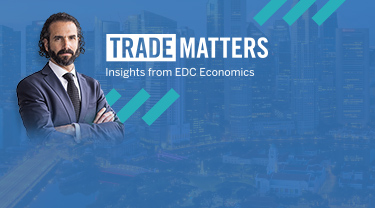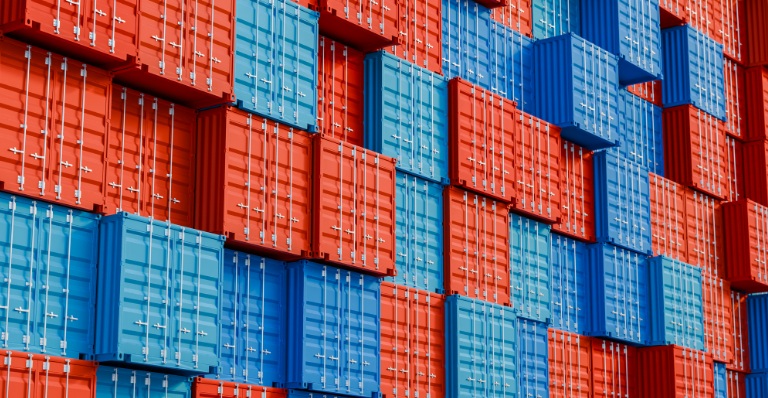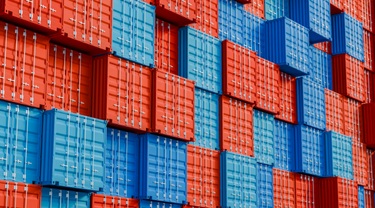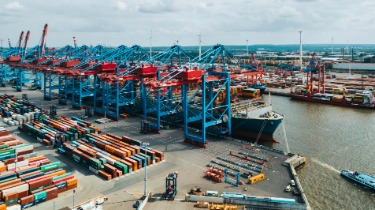Imagine the global economy as a giant game of Jenga. Every purchase, government initiative and business investment supported by resources, capital, technology and the activities of companies large and small. Pieces are traded up and down the tower with deliberate precision and—under the post-war order—general agreement on the principles that uphold the structure’s integrity.
That’s not to say it’s been perfect. Mistakes—whether self-inflicted or externally induced—have caused the structure to partially or fully crumble from time to time. Disagreement on tactics and perceptions of unfair advantage have occasionally encouraged a winner-take-all approach. But, for the most part, we continue to build together, recognizing that co-operation and our unique endowments are essential to maintaining balance and keeping the game going.
You should also check out
With growing risks, Canadian companies face new challenges. EDC’s Global Economic Outlook offers insights to help you make better business decisions.
This year, however, players held their breath as blocks were added, removed, paused and reinserted in unpredictable patterns. As summer faded, key trade agreements were finally jammed into place, offering some stability. But clarity doesn’t always mean the tower won’t wobble.
Costly, country-specific tariffs and countermeasures piled up, weighing against each other and building on a foundation of mistrust. Levies on metals, autos and parts, and agricultural products added tension across nearly every country’s side of the board.
EDC Economics’ Global Economic Outlook (GEO) assesses moves as of Sept. 15. While August rule changes and the end of “de minimis” loopholes are captured, any last-minute turns due to ongoing legal challenges are excluded from this round.
So, where does that leave us? The average effective U.S. tariff rate on goods imports was estimated at more than 18% in August—a sharp climb from the 2% rate that supported the global trade architecture for almost a century. Combined with months of uncertainty, it’s no surprise the global economy is teetering. Growth is expected to inch along at 2.7% in 2025, nudging up to 2.9% in 2026, as geopolitical tensions rattle the table.
The U.S. economy caused the tower to sway early in 2025, as a surge in imports slipped a critical block and growth stumbled. But in the second quarter, a resilient core helped the structure regain its footing. Companies have so far absorbed tariff shocks, keeping inflation from toppling upward, even as business and consumer confidence remains shaky. Still, a slowdown in job creation hints at potential destabilization ahead.
How are tariffs and interest rates impacting North America’s economy?
EDC Economics expects the U.S. to avoid a recession collapse, with steady—albeit underwhelming—growth, short of 2% in both 2025 and 2026. The U.S. Federal Reserve, shouldering the weight of public dissent as it balances its dual mandate, is expected to carefully take 50 basis points off its policy rate this year and another 50 basis points off in 2026.
Canada’s economy, by contrast, lost a few supports in the second quarter. Despite a strong export push early in the year, sector-specific tariffs and uncertainty have driven business investment in machinery and equipment to its lowest levels since the 1980s. Unemployment is rising, especially in cities most exposed to tariff tremors—Windsor, Oshawa, Calgary and Hamilton.
EDC Economics expects Canada to fall into recession in 2025, with growth stuck at 0.9%, before barely inching up to 1% in 2026. The reversal of many counter-tariff moves, and a relatively stable inflation underpinning give the Bank of Canada room to pull interest rates down three times in 2025, before pausing in 2026. Despite economic weakness, the Canadian dollar has benefited from players hedging against U.S. policy risk. We expect the loonie to average US$0.72 in 2025, rising just a notch to US$0.73 in 2026, as the Fed takes its turn in the easing cycle.
Why are gold and currencies reacting to global instability?
While many currencies have appreciated relative to the U.S. dollar, gold has been the biggest winner. Rising concern around the politicization of monetary policy—alongside a deteriorating U.S. fiscal position—has driven investors to seek shelter in the yellow metal. Since the start of 2025, gold has surged above US$3,600 per troy ounce, its highest inflation-adjusted value since 1980. We expect the price to average just over US$3,278 per troy ounce in 2025, and slightly less than US$3,469 in 2026, as volatility persists.
Turning to China—arguably the game’s most-watched player—early rounds saw pieces stacked precariously as U.S.-China trade tensions peaked. Now, with tariffs on Chinese exports down from a towering 145% to a much lower 30%, some weight has been lifted. Will this help China stabilize its layer? Perhaps a little, but policy-makers know the game isn’t won yet. Domestic weakness and a rapid reorientation of exports mean China’s focus will be on keeping its structure intact. With growth forecast at 4.8% in 2025 and 4.3% in 2026, we expect China’s stack to stand—for now.
Across the board in Europe, the Euro Area has long watched its blocks wobble compared to the U.S. But renewed borrowing and investment in defence and infrastructure are adding stability. Germany, with a strong fiscal package, reinforced its tier, while France remains fragile, threatened by political instability and government changes. Overall, the bloc is forecast to build at a 1.2% rate in 2025, but slowing to just 0.8% in 2026—steady, but not out of danger.
Though many countries reached trade agreements, both Brazil and India now face 50% tariffs on their exports to the U.S. While this adds tensions to their stacks, their foundations—supported by stable domestic conditions and limited reliance on U.S. exports—appear firm enough to prevent major collapse.
The bottom line: What’s the outlook for global trade amid rising tensions?
Just like a high-stakes game of Jenga, the global economy is in a delicate balance, each move watched with anticipation. As players reach for blocks, some nations have successfully pulled out the right pieces—negotiating reduced tariffs and strengthening their structures. While this may offer momentary relief, others remain in precarious positions, and the instability will bring new challenges for all.
Heading into 2026 and beyond, Canadian exporters will need a steady hand. The challenge lies in keeping the structure upright, knowing each turn brings both opportunity and risk to the game. But every move matters. So, whether you’re adding, removing, or just watching the blocks, keep your hands steady and your strategy flexible. In this game, resilience and adaptability are the only ways to come out on top.
For a deeper dive into the shifting dynamics of global trade, interest rates, currency trends and country-specific market insights, explore EDC Economics’ latest Global Economic Outlook—an essential guide for Canadian exporters navigating uncertainty.
Acknowledgements
This week, a very special thanks to Ross Prusakowski, deputy chief economist and director of our Country & Sector Intelligence team.
As always, at EDC Economics, we value your feedback. If you have ideas for topics that you’d like us to explore, please email us at economics@edc.ca and we’ll do our best to cover them
This commentary is presented for informational purposes only. It’s not intended to be a comprehensive or detailed statement on any subject and no representations or warranties, express or implied, are made as to its accuracy, timeliness or completeness. Nothing in this commentary is intended to provide financial, legal, accounting or tax advice nor should it be relied upon. EDC nor the author is liable whatsoever for any loss or damage caused by, or resulting from, any use of or any inaccuracies, errors or omissions in the information provided.







